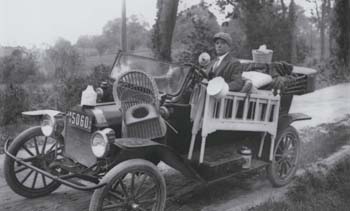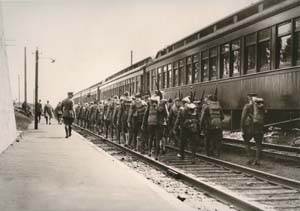 |
 |
| current issue |  |
past issues |  |
send a letter/news |  |
address update |  |
advertise |  |
about us |  |
alumni home |
On Ben's Farm
When Durham Fought the Fluby Mylinda Woodward '97
 Oren "Dad" Henderson preparing to flee the flu.
Oren "Dad" Henderson preparing to flee the flu.
|
On March 11, 1918, eight months to the day before World War I ended, a new killer that would prove more deadly than machine guns or mustard gas struck in Kansas when a young private at Fort Riley reported sick with a mysterious flu. Within a week, 500 more soldiers came down with the same symptoms, and 48 died. Soon, men in the trenches in Europe were dying from what was mistakenly labeled "Spanish Influenza," apparently carried there by troops from Fort Riley.
 Pass to return to the dorm.
Pass to return to the dorm.
|
In the United States, the flu reappeared in September at Camp Devens outside Boston. Lines of sick soldiers formed outside the infirmary. Many succumbed within 24 hours; 63 died in one day. Spreading to the civilian population, the flu moved quickly from state to state. Although by 1918 vaccines had been developed for diseases like smallpox, meningitis and diphtheria, modern medicine was powerless to fight "La Grippe." Some Americans resorted to folk remedies, like the Portland, Ore., mother who buried her daughter from head to toe in raw onions for three days. (Her daughter survived both the disease and the cure.)
Sleepy Durham was in imminent danger with five Army detachments stationed on campus for vocational training. The alert local commander, Capt. Dan Dickson, sounded the alarm of a deadly flu at Camp Devens after reading a Sept. 5 notice in area newspapers.
Three groups were at risk: the soldiers, living in close quarters in college housing; the student body—mostly women—due to return to campus soon; and the residents of Durham. Complicating matters, a collegiate military group, the Students' Army Training Corps, was scheduled to report to campus on Sept. 25.
 Military escorts for recruits.
Military escorts for recruits.
|
Officials acted quickly. Dickson immediately quarantined the camp, and President Ralph Hetzel delayed the opening of college. All social events were cancelled, and guards were placed at buildings and along streets. A pass was required to walk on Main Street; getting the pass entailed an inspection by a doctor. Some young faculty members, including Oren "Dad" Henderson and Eric Huddleston, packed the family and a few household essentials and left town.
Despite these precautions, a corporal from Company C, Clarence Post, came down with the flu and died on Sept. 20. Soon other soldiers were taken ill, and Bickford house, intended for women students, filled with patients; Sigma Alpha Epsilon and Kappa Sigma houses were taken over as hospitals as well. During the epidemic, Capt. Dixon and Lt. Barnwell of the medical corps won the lasting gratitude of the soldiers for their tireless care, but in spite of their efforts, 11 men died.
 Training corps induction, Oct. 10, 1918.
Training corps induction, Oct. 10, 1918.
|
While the flu hit hard and fast, it left almost as quickly as it arrived. On Oct. 7, the college cautiously opened its doors to male students and training corps recruits. By Oct. 19, women students were allowed into their dorm—but only after having their temperature taken—and on Nov. 5, the quarantine was finally lifted from the Army camp.
Across the country, the flu sputtered out by the end of the year, leaving more than 600,000 dead despite the frantic exertions of federal agencies and civilian groups. In Durham, a vigilant commander, a decisive president, common-sense prescriptions and town-and-gown collaboration helped prevent a calamity from turning into a catastrophe.
blog comments powered by Disqus

